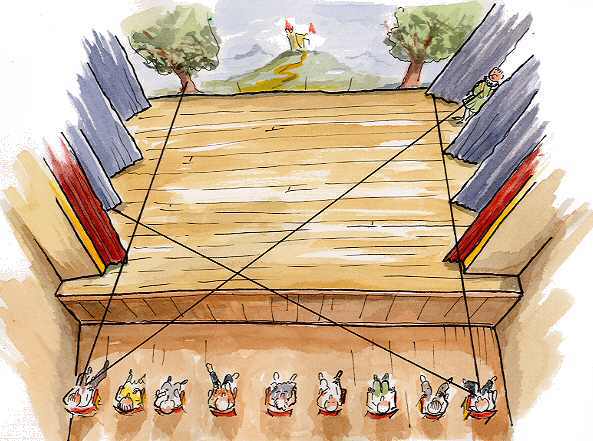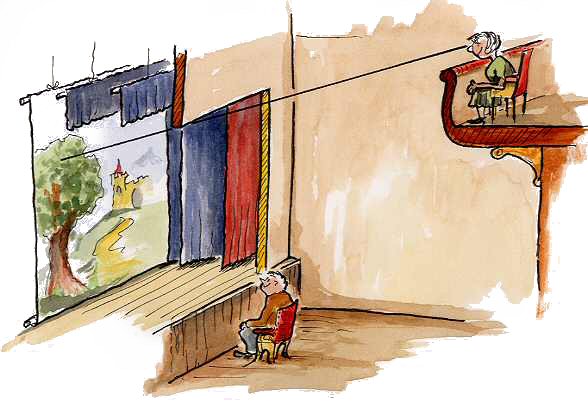SCENERY
PAINTING FOR THE AMATEUR MUSICAL THEATRE and PANTOMIME
|
THE STAGE
What do we need to know from looking at the stage? (Some of these queries
can be left until nearer the time- we don't want the management committee
panicking too soon that you're going to ruin the place!)
The sight lines.This is discussed here from the point
of view of the scenic artist and not the SM; Director; or Producer, who
will be more interested in masking
from these "extreme" seats.
In our case it helps to know the cut-off point to plot the "safe" area
on the cloths and wings. These are the areas that can be seen by everyone
in the audience. And it's within the confines of these areas that you
can place your important scenic elements.

For instance I recently designed/painted for a production of the Wizard of Oz and for Munchkinland had Dorothy's house Downstage Audience Right. It was important that everyone in the audience could see the witch's legs sticking out from under that house, so there was some shuffling about of that wing during the setting up to ensure the seat on the right could see the legs.
Discuss with the Caretaker if any decisions have been made regarding a centre or side aisles, as this will affect the seats for your sight lines. Sometimes it is the Producer who can influence where the audience seating aisles will be, but more often than not it is the local fire authority that has laid down rules for that particular hall..

Vertical sight lines
Is there a balcony? Are the audience
seats raked? If so then you'll have to paint the tops of steps, tables
etc.
Any borders (or are you going to paint some?)
If there is a balcony, go up into it and view the stage from there to check
just how far down the borders hang, How much will the borders, or pros. arch,
mask
the scenery at the back of the stage?
Is it all right to paint scenery on the stage? -"Of course I'll be very careful not to smear the curtains Mr. Caretaker and I'll lay down tarpaulins".
If there's something going on in the hall, (five-aside football match for instance) if I draw the main curtains can I still keep on working?
If it's a raked stage or auditorium is it worth asking if you could paint the stage floor?
STORING MATERIALS
Anywhere I can make my "paint-store"?
Will the paint store floor need covering?
THE HALL
Where's the nearest entrance for me to get my car (full of paints) parked?
Must obviously try to avoid a long trudge moving the materials.
Where can I wash my brushes?
Can I get a bucket under the tap?
What hours, and days, will the hall be open, for me to get in and work?
Any chance of letting myself in and out when the hall is closed?
Any chance of a set of keys?
Where are the light switches?